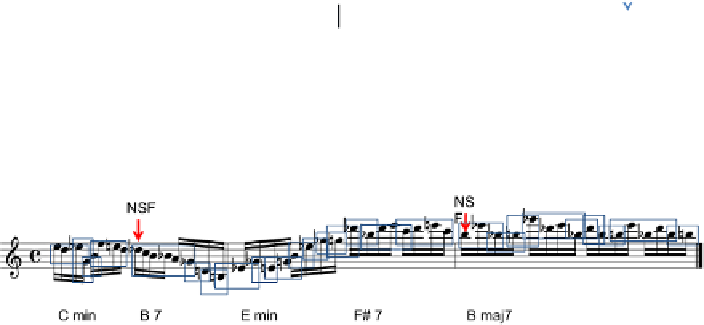Information Technology Reference
In-Depth Information
Fig. 5.20
A phrase generated on a C minor chord sequence. The compositions of the segments of
the training phrases are indicated by overlapping boxes. Segments of length 2 to 7 are being used
in this case. Training phrases #2 to #6 have been used. No NSF case is encountered
Fig. 5.21
A phrase generated on the sequence
Cmin/B7|Emin/F#7|Bmaj7
.TwoNSF
cases were encountered, indicated by an
arrow
(and non-overlapping boxes): for the
Cmin
→
B7
transition, and for the
F#7
Bmaj7
one. They were addressed using the one-step-max theorem.
The discontinuity is not musically perceptible by the author
→
5.5 Escaping Markovian Boredom
Once we have established the basis for generating melodies that comply with the
rules of the game, we can now describe how to model the two important innova-
tions that bebop has introduced in jazz. These two innovations relate to boredom:
producing phrases that satisfy the criteria we have described is pleasing, but may
lead to boredom after repeated exposure. From a computer science perspective, we
call 'Markovian Boredom' the sensation that the phrases generated all come from
the same set of rules, grammar, and that, eventually, there is no hope of hearing
something new, striking, outstanding. From there on, boredom follows irrevoca-
bly.
As described in the introduction, two devices have been invented by jazz musi-
cians to escape boredom. These devices have in turn contributed to changing the
style itself. We describe here how these two devices can be modelled in our Markov
framework, the issues they raise technically, and how they can be addressed.
5.5.1 Side-Slips and Formal Transforms
The model we have introduced so far generates notes streams on arbitrary chord
sequences, which are continuous and satisfy local harmonic constraints. In the ex-
amples shown here, we use a limited training material (about six phrases for major,
minor and seventh, three phrases for diminished and whole-tone, used in particular


































































